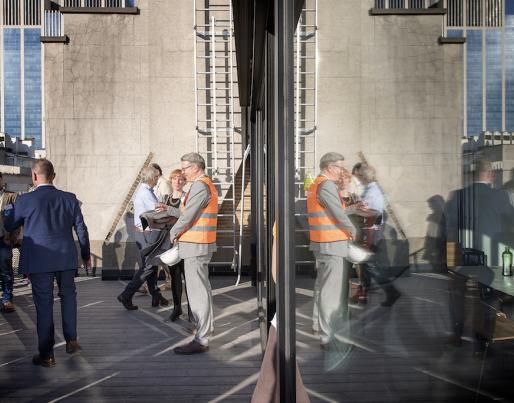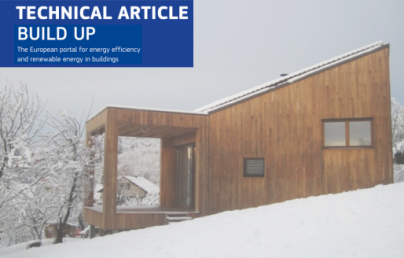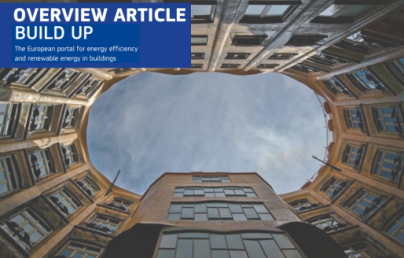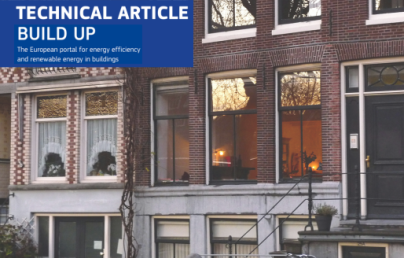Finance and investment challenges presented in the 8th edition of Renovate Europe’s REDay

Finance and investment challenges presented in the 8th edition of Renovate Europe’s REDay
The Club of Rome’s first report and early whistle-blowers’ calls from the late 1960s on the Earth’s environmental stress, are today backed by concrete facts and data on the need for change. A significant 40 % of energy use relates to construction and buildings, a key element of the equation. The current energy demand of existing building stock needs to be drastically reduced. This is particularly true in the European context, and this is what has inspired the Renovate Europe campaign, launched in 2011 at the initiative of several associations and companies under the EuroACE -Alliance of Companies for Energy Efficiency in Buildings.
The set goal of the campaign is ‘to reduce the energy demand of existing EU building stock by 80 % by 2050 as compared to 2005 consumption levels’. Hence, a significant increase in the quality and quantity of the renovation rate of buildings is needed. The current rate of about 1 % should reach ‘3 % per year by 2020 and maintain that rate until 2050’.
The campaign has had as an annual beacon the REDay event, which brings together stakeholders, experts and policymakers. From the beginning broader social and economic implications were taken into consideration for the campaign’s activities and put forward at these events, alongside topics such as the reduction of the environmental footprint, building technicalities, and the direct energy and financial savings.
The first 2011 edition hosted the launch of the Buildings Performance Institute Europe (BPIE) study Europe’s Buildings Under the Microscope, which analysed Europe’s building stock, quantified the benefits and potential barriers of renovation, and proposed approaches to overcome them. The focus of the 2012 edition was made clear by REDay’s title Stimulating jobs and growth in Europe, which underlined the economic opportunity for Europe in line with EU policy on social cohesion.
The Multiple benefits of energy efficient renovation of buildings - Impact on public finances study by Copenhagen Economics was then presented. This study confirms, with quantified scenarios, how ‘the energy-efficient renovation of the EU building stock is one of the most attractive and low-cost options available to the EU to save energy, reduce CO2 emissions and reduce dependence on imported fuels’, alongside ‘permanent annual economic benefits to public finances and to society at large’ (Naess-Schmidt 2012). Furthermore, in 2012, funding and investment for energy efficiency in buildings were addressed through diverse points of view ranging from the European Commission’s Directorate-General for Regional and Urban Policy to real estate and financial sector actors, while Ireland’s ongoing practical experience of promoting residential and commercial upgrading of existing buildings were highlighted.
Along with updates of the evolution of the EED and EPBD directives, later REDays have pertinently kept track of the investments in and operational implementation of the energy renovation of buildings. Public and private initiatives in different countries were explored as well as experiences and cases ranging from individual building projects to ones with regional and national scopes. The emphasis was on the relevant actions at the city level – with the pioneering examples of the policies of Brussels and Dublin. The ‘positive returns for public finances of energy efficient renovation programmes’, the gains in productivity of the occupants and the impressive health-care savings for inhabitants of adequately and energy efficient renovated buildings were underlined (2015, 2017).
As multiple ‘savings’, lasting employment creation and growth arising from large-scale, long-term renovation programmes are easier to ‘sell’ when it comes to the actual financing and investments required for implementation, smoothness is less an issue than hesitation and short-term focus. This kind of reluctance would apply to social housing organisations, small landlords, and individual owners, as well as to finance ministries or financial institutions – hence constituting a stumbling block and a set of challenges to overcome to move forward with Renovate Europe’s vision.
This year’s 8th REDay edition, held at the European Parliament on 9 October 2018, focused on this topic and was addressed in particular by Marjolaine Meynier-Millefert (Member of the French National Assembly), Stephen Richardson (World Green Building Council) and Stephanie Sfakianos (BNP Paribas).
Marjolaine Meynier-Millefert, member of French Executive Council for Construction and Energy Efficiency and Co-Chair of the Building Renovation National Plan, reports proactive and prioritised institutional commitment to implement the Paris Agreement and clear goals aiming at NZEB and decarbonised building stock for 2050. This is being done with an important focus on alleviation of fuel poverty, aiming at the eradication of F or G rated situations by 2027 and with a targeted pace of 500 000 renovations per year. Tertiary sector buildings are also considered and public schools in particular. The allocated budget for the national building renovation plan: EUR 14 billion over 5 years, and EUR 200 million is foreseen to be oriented over the next 3 years towards professionals in the building sector to reinforce skills and innovation.
In concrete terms, several financial tools and fiscal measures were highlighted, besides the recently launched (09/2018) FAIRE branding campaign and call to action – aiming at the concertation of the numerous public and private sector actors and the clarification of roles and views towards the common goal of renovating France’s building stock to high standards of health, comfort and energy efficiency.
Starting from the fact that since 1999 the VAT tax rate for renovation works was set to 5.5 % instead of 20 %, it is worth mentioning that the (overwhelmingly) successful Energy Transition Tax Credit (CITE) of 30 % was launched in 2015 to assist house tenants in the purchase of material and equipment to limit energy consumption. Also to address the residential sector, the eco-prêt à taux zero / zero-interest rate eco-loan scheme has been in place from 2009 offering main-residence owners loans of up to EUR 30 000 for works on energy efficiency and renewable energy.
The Energy Saving Obligation scheme (White Certificates), intended for the residential and non-residential sectors, uses the same principles as the European Union’s Emissions Trading Scheme. Through this device, energy retailers and fuel suppliers are obliged to meet specified energy saving targets, notably by encouraging their customers to reduce energy consumption. Fines for retailers and suppliers for non-compliance may be substantial, offering additional income to public finances, which are in turn dedicated to energy savings programmes. (This system nonetheless leads to some tensions, as the consumption reduction outcome is not necessary under the control of the obligated parties – aspects to take into consideration to avoid deleterious effects).
The overview of national policy dynamics in France, with increased attention in regards to the areas of large-scale sustainable building retrofitting, and the corresponding funding they require, shows a comprehensive view of the diversity of approaches needed – and this applies from the macroeconomic and European levels to the sub-regional, cities and local levels. Measures such as energy performance contracting schemes, multi-actors partnerships, fiscal incentives and a variety of schemes of bonds and loans are tailored to achieve high-standards and the cost-effective retrofitting of buildings. These later schemes were discussed, in 2018, in the interventions by the speakers from the finance sector and from the World Green Building Council.
Stephen Richardson, Technical Lead for the Energy Efficient Mortgages project (EeMAP), in which the Europe Regional Network of the WorldGBC is taking part, spoke about the principles sustaining the overall goals of ‘developing a market of financial products that stimulate real progress on energy renovation’, with clear and common standards at the European level. The logic for all stakeholders is that drastically reduced energy costs are directly linked to lower interest rates while the property’s value, health and comfort rises. As investment in SMEs and demand for efficient buildings rise, energy consumption and carbon emissions decrease. This is easier said than done. General awareness and motivation are to be addressed at large, while coordination (within industry, governments, banks…) and standardisation are also key factors of success, which the project also tackles. In Richardson’s view, a key factor that is still missing is strong and responsible political leadership!
And indeed, a lack of coherence, or even contradictory trends and decisions at high levels of government, are not rare said Bendt Bendtsen, Danish MEP and Rapporteur of the revision of the EPBD directive. He presented the much improved 3rd version of the Directive. This was confirmed as well by Meynier-Millefert. The Ministry of Finance sees energy efficiency funding as budget expenditures, failing to understand and embrace the investment and opportunities the funding represent. There is a need for a paradigm shift, and it is worth quoting Phil Sumerton (Managing director of Cambridge Econometrics): ‘No matter how far you go in ambition, Europe’s economy will be better off!’ (REDay 2017)
Stephanie Sfakianos, Head of Sustainable Capital Markets of BNP Paribas, currently works on the setting up and launching of a green mortgage pilot in the UK. The pilot is integrated with the EeMAP project. She provided the context of the international background of the topic, where current financial markets trends show a substantial increase in interest in the green/sustainable bond market, which was quasi non-existent a decade ago and nowadays reaches more than USD 400 billion in cumulative issuance terms.
Green bonds are today actually ‘a key worldwide policy instrument, for the G20, the BoE, the People’s Bank of China, OECD and the EU amongst others’. For instance, European workplace pension schemes are now required to openly incorporate environmental, social and governance (ESG) factors into their risk assessments. In regard to this evolution, it is noted that if the drivers in the market for ‘Socially Responsible Investments’ may vary at some points from clients to banks, both sides respond to regulatory and social pressures and to the opportunity to reach advantaged and secured positions. Within this context, it is worth noting the reference to the Financial Stability Board (FSB)’s Task Force on Climate-Related Financial Disclosures (TCFD), aiming at international cooperation to formalise a framework for the provision of ‘decision-useful climate related risk information’, providing specific considerations on mortgage lending and on the Residential Mortgage-Backed Security (RMBS) market. The link is here done to the EeMAP project, whose standardisation and reporting of ‘energy mortgages’ would be a leverage for the need of scaling the RMBS market.
A concrete and remarkable example is the case of the Dutch mortgage provider Obvion, which launched in 2016 the first green RMBS ‘Green Storm 2016’ (with a total transaction of EUR 500 m), backed by a pool of green residential mortgages based on Dutch energy performance labels and basically financing a 2 level or 30 % improvement in the energy performance rating. The project ‘Storm’ has been reconducted in 2017 and 2018 reporting now outstanding securities of EUR 17.4 bn.
We have come a long way in the fields of Renovate Europe’s goals. Recent agreements on the EU’s clean energy package and the evolution of the EED and EPBD directives are concrete and positive achievements of European policy. Now, crucial and major challenges lie ahead on the process of the transposition and implementation of the directives at national and diverse local levels, as emphasized by Renovate Europe’s Campaign Director Adrian Joyce invitation to the 2018 REDay’s edition.
In summary, addressing the integral renovation of European building stock requires multiple approaches and the strategic and adaptive application of various investing, financing and funding schemes. Experience is building up and fine-tuning allows better adequation between the financial funds sector needs and those from the real estate energy-efficiency renovation sector. Nonetheless, a number of tools are already available. Likewise, the technical solutions for coherent zero-energy retrofitting – even if these may and should be subject to innovation and amelioration – are available today.
In the same line, the tools and programmes for upgrading construction skills and the technical capacities of professionals in the sector are to be funded and promoted. Finally, building managers and owners, direct clients and decision-makers are to be strategically, rationally and emotionally addressed concerning renovation works. Carrot-enticement approaches, with appropriate technical accompaniment, are to be balanced by coherent and clear stick-constraining policies and regulation, and with the exemplary lead of the public sector, lead to consistent renovations of residential, educational and tertiary public buildings.


